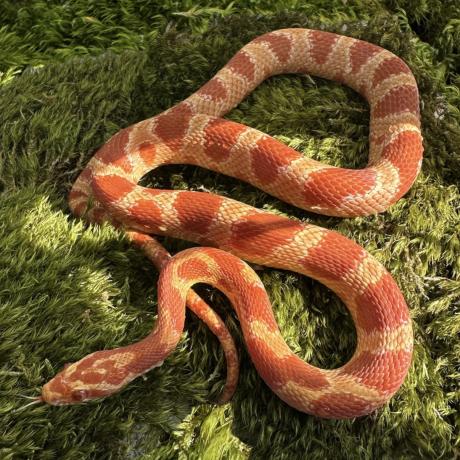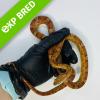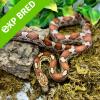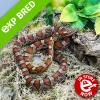

Corn Snakes come in a huge variety of colours. They are a easy handling size and have a calm disposition. These animals are reluctant to bite, constrict or defecate under mild stress like other species. Suitable for any experience level.
| Origin | North America |
|---|---|
| Environment | Widespread |
| Adult Size | 4-5ft |
| Suitability | Beginner |
| Lifespan | Up to 20 years |
| Temperament | Docile |



Corn Snakes are arguably one of the most popular pet snakes. This species grows to an average length of 4 foot (1.2 m) but can be anywhere between 3 - 5ft. They are available in a range of different colours and morphs, but nearly all of the corns have a characteristic "V" shape on their head. Most display a saddle pattern, patches down the length of the body, often with a distinctive chequered pattern on the belly scales. Some of the most popular colours or patterns (known as ‘morphs’) you can purchase are as follows; Amelanistic, Anerythristic, Ghost, Candy Cane, Fluorescent, Hypomelanistic, Motley, Snow, Stripe and many more - too many to list!
If you want to own a snake for the first time, this is the ideal "Pet Snake". They have a calm nature, can be handled and are easy to maintain and feed.
In the wild, they are found in Southeastern United States ranging from New Jersey to the Florida Keys.
They prefer habitats such as overgrown fields or crops, forests, trees and in derelict buildings and farms.
Corn Snakes have to be one of the easiest species of snake to own, as long as their environmental requirements are met.
It is a common myth that they prefer a smaller enclosure, often with suggestions that If the enclosure is too large, this could cause stress to the Corn Snake- this is NOT TRUE. Breeders commonly keep this species in racks, but research shows that the lack of space and mental stimulation caused by this environment can potentially have long term implications to the snake. The main thing to consider with using larger enclosures is ensuring the snake cannot escape. Young Corn Snakes can be housed in slightly smaller enclosures 24x15” (LxW), but sub and fully-grown adults thrive in a 48x18x18” (minimum) vivarium.
You will need to provide your Corn Snake with a basking temperature of 30C (85F) during the day with a drop down to 25C (75F) at night. You can maintain the temperatures by using either a basking lamp with a guard or a heat mat for hatchling enclosures, a thermostat should control all heat sources to avoid risk of overheating.
We advise the use of low level UVB lighting for your Corn Snake, research shows that UVB exposure contributes to healthy animals, both mentally and physically. Many snakes will cryptically bask by leaving a part of their body exposed to the sunlight when hiding. The lighting is recommended to be on for 12 hours during the day and switched off at night to allow for a natural night time light and temperature drop.
They require moderate humidity levels, and if kept too dry, this can cause problems shedding their skin. A humidity box filled with damp moss can also be useful to aid the shedding cycle. Fresh water should be provided daily in a dish/bowl so your snake may drink or bathe. This is very important when your Corn Snake is due to shed its skin. Once you notice the Corn Snakes eyes go clear after being cloudy, you can increase humidity by spraying the enclosure lightly. The animal should then shed within 24hrs.
For Corn Snakes you can use aspen, bark chips or soil/coir based substrates. This should be deep enough to burrow into should they choose to. Corn Snakes though often provided with fairly basic enclosures, do prefer a more ‘cluttered’ enclosure, with the addition of multiple hides, cork bark, branches, plants all at different levels provides enrichment and helps the animal feel safe. By providing multiple safe places to hide, the corn snake is more likely to spend time out in the open; rather than spending all of its time in the hide if there are only a couple of safe options.
Feed your Corn Snake on defrosted mice. The biggest issue with corn snakes is that they are naturally greedy! It is easy to fall into the trap of overfeeding, and as with any species, becoming obese can result in health complications and ultimately a premature death in extreme cases. The size of food given depends on the size of the snake, this shouldn’t be any larger than the widest part of the animals body. Young Corn Snakes should be fed every 7-10 days, older Corn Snakes every 10-14 days and adults should be fed every 3 weeks with breeding females being fed every 2 weeks. It is best to make a log of when your snake eats and sheds its skin, this helps to spot any patterns or behaviours linked to the feeding cycle.